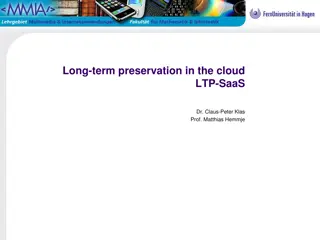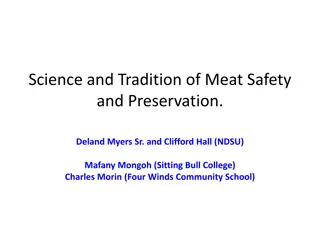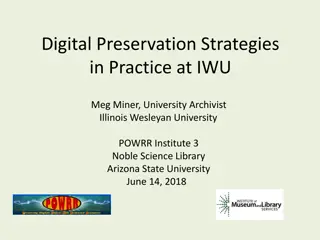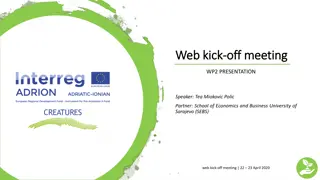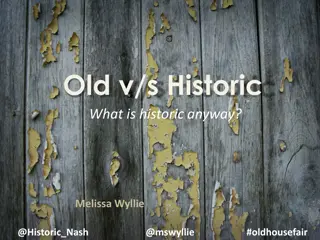National Historic Preservation Act: Background and Requirements
The National Historic Preservation Act (NHPA) was established in 1966 to protect historic resources in the United States. It was a response to the alarming damage caused by large-scale projects post-World War II. The Act requires federal agencies to consider the impacts of their undertakings on historic properties and imposes restrictions on projects that significantly affect these resources. Key terms like the Advisory Council on Historic Preservation and the National Register of Historic Places play crucial roles in enforcing the NHPA. Overall, the NHPA aims to preserve the nation's cultural heritage for future generations.
Download Presentation

Please find below an Image/Link to download the presentation.
The content on the website is provided AS IS for your information and personal use only. It may not be sold, licensed, or shared on other websites without obtaining consent from the author.If you encounter any issues during the download, it is possible that the publisher has removed the file from their server.
You are allowed to download the files provided on this website for personal or commercial use, subject to the condition that they are used lawfully. All files are the property of their respective owners.
The content on the website is provided AS IS for your information and personal use only. It may not be sold, licensed, or shared on other websites without obtaining consent from the author.
E N D
Presentation Transcript
Welcome CHAPTER 9: State/Federal National Historic Preservation Act Regulatory Training Program
Learning Objectives for NHPA Identify Requirements applicable to the fishery management process Recognize what triggers these requirements Locate and Apply Guidance for complying Plan a timeline
Background and History of NHPA After World War II, the United States experienced a period of rapid socioeconomic change. The Federal government initiated several large-scale projects, including the construction of dams and reservoirs by the U.S. Army Corps of Engineers and the creation of the Interstate Highway System under the Eisenhower Administration. Established by the National Interstate and Defense Highways Act of 1956, the highway system was intended to enable rapid deployment of troops in the case of an attack. These projects resulted in alarming damage to historic neighborhoods, buildings, structures, and archeological sites. In the 1960s, the Kennedy Administration created the Urban Renewal Program, which was focused on revitalizing city slums , sometimes at the expense of historic resources. During the Johnson Administration, First Lady Bird Johnson initiated a beautification program which led to the production of a comprehensive report, With Heritage So Rich. The report recommended creating a national historic preservation program, which ultimately led to Congress passing the National Historic Preservation Act in 1966.
Overview Requires federal agencies to consider the effects of their undertakings on historic properties in the United States, including the outer continental shelf and the exclusive economic zone (section 106, 16 U.S.C. 470f). Outside of U.S. must take into account adverse effects on sites on World Heritage List Requires agencies to withhold permits or funding for applicants who intentionally significantly adversely affect historic properties. b
Key Terms: ACHP (Advisory Council on Historic Preservation) Independent agency Advises President and Congress on historic preservation matters, Reviews agency policies and programs to improve their consistency with the purposes of the Act, Administers 106 review process
Key Terms: National Register of Historic Places Over 89,000 properties listed Over 600 vessels and shipwrecks, some on Outer Continental Shelf
Key Terms: Undertaking A project, program , or activity funded, permitted, or licensed by a Federal agency
Key Terms: Historic Properties Any prehistoric or historic district, site, building structure, or object Included on, or eligible for inclusion on, the National Register
Key Terms: National Register of Historic Places List is Maintained by Secretary of Interior. Includes sites significant in American history, architecture, archaeology, engineering, and culture. Landmarks meet criteria at 30 CFR 60.4 Provides for state programs. Special Provisions for Indian Tribes and Native Hawaiian Organizations
Key Terms World Heritage List: a Foreign Nation s equivalent of the National Register for purposes of avoiding or mitigating adverse impacts.
Key Terms Section 106 Process: Regulatory process by which Federal agencies take into account effects of action on historic properties. Includes comment process for the Council on Historic Preservation.
How the Process Works Initiate Section 106 Process Is it a type of action that may affect historic properties? If yes, identify the State Historic Preservation Officer (SHPO) or Tribal Historic Preservation Office (THPO) to consult with If no, then done
How the Process Works If a project has potential to affect historic property (listed or eligible) The Federal Agency must identify historic properties within the Area of Potential Effects Review existing information on the area Seek additional information as appropriate may involve background research, consultation, oral history, interviews, investigation, field surveys Consult with Indian tribes and Native Hawaiians (religious, or cultural significance)
How the Process Works IF the action is a type that may affect, then The agency identifies historic properties in the area (listed or eligible) Can be a very broad inquiry Park Service can provide formal eligibility determination If no properties, then the agency documents the finding and provides it to SHPO/THPO for 30 days If no objection, proceed If properties are present, assess adverse effect
How the Process Works Assess Adverse Effects Resolve Adverse effects (consult on ways to avoid, minimize, or mitigate adverse effects) Memorandum of Agreement Or Agreement that adverse effects must be accepted for public interest
Consultation with Council (ACHP) When consultation with state or tribe terminates without agreement, agency MUST consult with ACHP Depending on which party terminates, ACHP will either enter an MOA with action agency, provide formal comments, or provide advisory comments Be aware of addressing comments reasonably on RECORD
Example: Monk Seals 2014 Programmatic Environmental Impact Statement; Appendix B; Final PEIS for Hawaiian Monk Seal Recovery Actions; March 2014
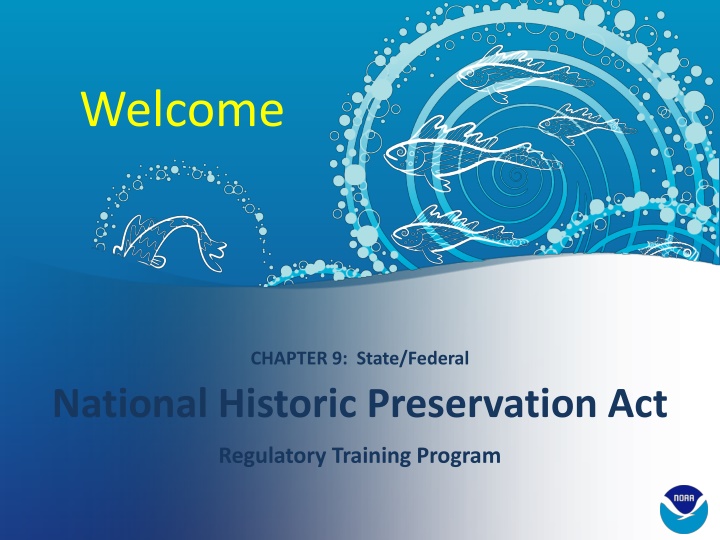



![❤[PDF]⚡ Apollo Mission Control: The Making of a National Historic Landmark (Spr](/thumb/21551/pdf-apollo-mission-control-the-making-of-a-national-historic-landmark-spr.jpg)




